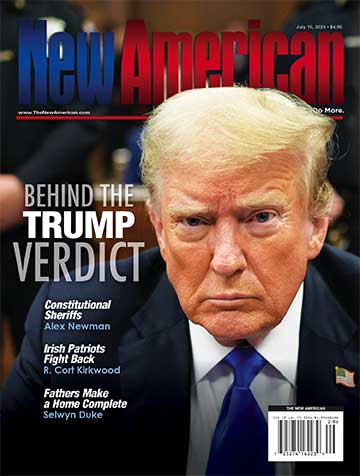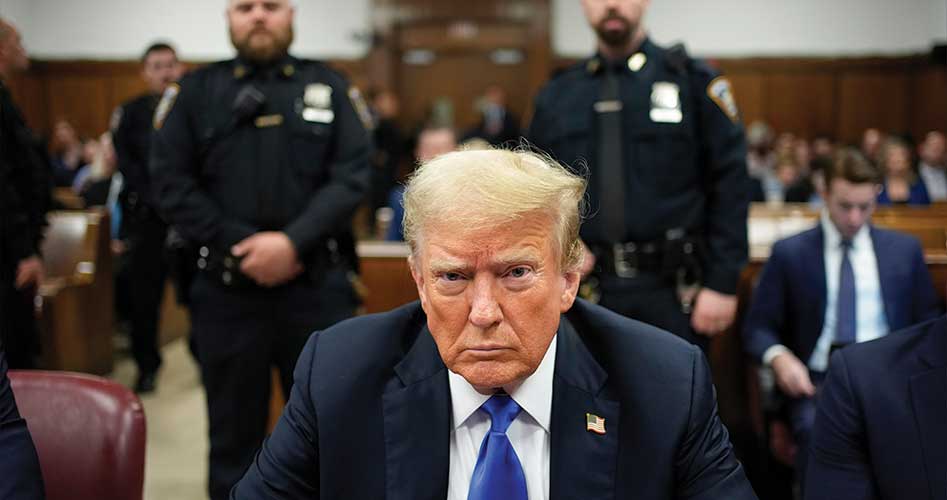Behind the Trump Verdict
It was a sight right out of a legal thriller. Twelve jurors in a Manhattan courtroom emerged from their chamber after 11 hours of deliberation, verdict in hand. As they walked past the accused, former President Donald Trump, none of them would look him in the eye, according to a journalist who witnessed the event, even though Trump was looking right at them the entire time. The averted gaze being the surest tell of a guilty conscience, Trump — and everyone else in the room — must have known then, even before the verdict was read, what the outcome would be. To the surprise of none who had been following closely the sordid twists and turns of Manhattan District Attorney Alvin Bragg’s and Judge Juan Merchan’s show trial, the jury found the former president guilty on all 34 of the ludicrously vague charges against him. Trump exited the courtroom with little fanfare other than a few hugs and handshakes with his supporters.
But once outside the courthouse, he did not hold back. “This was a disgrace. This was a rigged trial by a conflicted judge who was corrupt, a disgrace,” Trump fulminated to gleeful members of the press. “They wouldn’t give us a venue change. We were at five percent or six percent in this district and this area…. The real verdict is gonna be November 5, by the people, and they know what happened here, and everybody knows what happened here.”
That was Friday, May 31, 2024, a date destined to live in jurisprudential infamy. On that day, a stacked jury told a biased judge that, based on spurious evidence for non-crimes and a legally incomprehensible set of instructions for deliberation, former President Donald J. Trump was guilty of doing something — no one is quite sure what — bad. The judge himself seemed unclear on the issue, telling jurors, in what must surely be one of the most preposterous prosecutorial flights of fancy since the days of blood libels, inquisitions, and autos-da-fé, that they need not agree on precisely what Trump had done wrong, but only that he had done something wrong from an approved menu of putative offenses. Concurrence on that point alone was sufficient for a guilty verdict, he assured them.
Compared with the drama of a terrorist attack or a war, the events of May 31 might appear innocuous. But if the verdict is allowed to stand and the perpetrators of this monstrous miscarriage of justice go unpunished, the consequences for America will be every bit as momentous as Pearl Harbor and 9/11 — and, quite possibly, far more damaging to the body politic in the long run.
How have things come to such a pass? It all allegedly started nearly two decades ago, at a celebrity golf tournament in Nevada in July 2006, when Donald Trump, then host of the hit TV series The Apprentice, met pornographic film star Stormy Daniels (real name Stephanie Clifford). Trump, who was already married to Melania at the time, allegedly invited Daniels to his penthouse, where the two had an adulterous liaison — this, at least, is Daniels’ version of the story; Trump has steadfastly denied it.
Nevertheless, when Trump began having presidential aspirations a few years later, Daniels began looking for ways to shop her story. When the celebrity magazine Life and Style, which had offered Daniels $15,000 for the story, approached the Trump organization for comment, Trump’s lawyers threatened legal action, and the periodical backed off. The story was subsequently leaked online before being removed under threat of a lawsuit. Once Trump’s presidential campaign geared up in 2016, however, the scandal rag National Enquirer was poised to run the story, and only intervention by Trump lawyer Michael Cohen to the tune of a $130,000 non-disclosure agreement with Daniels (which the media have persistently characterized using the sleazy-sounding and imprecise term “hush money”) prevented the story from coming out. Cohen raised the money via a home-equity credit line, and was subsequently reimbursed more than $400,000 via several personal checks from Donald Trump. The additional money was for various services rendered, taxes, and interest.
Cohen himself — like the lawyer who helped propel Stormy Daniels to fame, Michael Avenatti — turned out to be morally conflicted, to say the least. After an aggressive investigation by the DOJ in 2018 that featured an FBI raid on Cohen’s office and was transparently an early effort to get the goods on Trump by elements within his own Justice Department, Cohen pleaded guilty to five counts of tax evasion, one count of willfully causing an unlawful corporate campaign contribution, one count of making false statements to a financial institution, and one count of making an excessive campaign contribution in hopes of influencing an election. After his pleas, Cohen indicated a willingness to sing like a canary to implicate Trump, the man he later said had caused him to “choose the path of darkness.” He sat for many hours of interviews with special prosecutor Robert Mueller during his investigation of Trump. Despite his eager cooperation with federal investigators, Cohen was sentenced in December 2018 to three years in prison and nearly $2 million in fines and restitution for what his sentencing judge called “a veritable smorgasbord of fraudulent conduct.”
He said, she said: Porn star Stormy Daniels has long alleged a one-night stand with Trump in a Nevada hotel in 2006 — while trying to make money off her story for years. Trump has denied even knowing her. (AP Images)
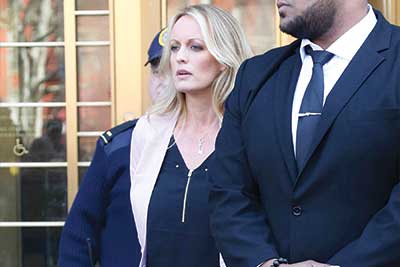
Cohen also was charged by the Mueller investigation itself for lying to both the Senate and House Intelligence Committees regarding a separate matter, the much-ballyhooed Trump Moscow Tower deal, which D.C. Deep Staters had tried to use early on to support their bogus charges of Russian collusion. Although the lies alleged to have been told by Cohen were comparatively trivial — for example, misstating by several months the date when the deal ended — his insistence that he lied on Trump’s behalf rang increasingly hollow as more evidence came out, including the special counsel’s own disavowal of a sensational story by BuzzFeed alleging that Trump had directed Cohen to lie to Congress.
At the time, the Russia Collusion hoax, and Cohen’s role in it, seemed sordid enough to any sober observer — an obvious attempt by the Deep State, led by former elements of the Clinton campaign, to destroy President Trump via a completely manufactured scandal. But in hindsight, they were a mere dress rehearsal for what was to come.
The prosecutorial potential of the salacious Stormy Daniels affair was not lost on the same elements in the Deep State and in the New York state judiciary who detested Donald Trump and were looking for any legal pretext, however flimsy, to bring him down. Already in 2018, investigations had begun in earnest to determine whether anything about the “hush money” payments could be laid at Trump’s feet. Both former Manhattan DA Cyrus Vance and the U.S. attorney for the Southern District of New York launched investigations into Trump and his associates soon after Cohen’s guilty plea in 2018. Federal investigators concluded by mid 2019 that there was no evidence of federal crimes, and ended the investigation in July of that year. The Manhattan investigators, driven, perhaps, by greater personal animus toward a man they considered a disgrace to the Big Apple, strove mightily, but also let the matter lapse. The most obvious path — electoral fraud — was a difficult road, being in most cases under New York law a simple misdemeanor. And the evidence that Trump was complicit even in that was sketchy at best, based as it was primarily on hearsay from Cohen, a many-times-convicted felon and perjurer.
The investigation went dormant toward the end of Vance’s term in office. But, as everyone knows, Vance was replaced as Manhattan DA in 2021 by Alvin Bragg, a smooth-talking race hustler and certified Trump nemesis who, in one of the more Dickensian nomenclatural ironies of the entire saga, bragged repeatedly during his electoral campaign that, once in office, he would make it his life’s mission to get Trump.
And Bragg, whatever else may be said about him, was as good as his word regarding that campaign promise. His early tenure as Manhattan DA was marred by the same pathological indifference to violent felons as that displayed nationwide by radical-left Democratic mayors, district attorneys, and Biden administration immigration officials. But Bragg was a man on a mission. Lacking infinite resources, he chose to ignore New York’s burgeoning violent crime, and dedicated most of his department’s energy to going after his bête noir, a man he hated as the very embodiment of white privilege and whom he intended to repay by removing him permanently from the political arena. That meant something more than frivolous misdemeanor charges — on which the statute of limitations had already expired in any case.
Bragg figured out a way around the statute of limitations, however. On the novel legal theory that the charges could be elevated to felony status if they could be proven to have been committed in the furtherance of some other crime, Bragg and his associates reasoned that they could still hang felony charges — whereof the statute of limitations had not run out — on Trump, and bootstrap their way to indictments, a trial, and a conviction.
Once the fix was in, courtesy of Bragg and his team of latter-day inquisitors (which included a recent émigré from the Department of Justice and presumptive liaison with both the DOJ and the Biden administration, Matthew Colangelo), the rest of the process unfolded with dreary and predictable inevitability. In January 2023 a Manhattan grand jury (which proved no less inquisitorial than the trial jury) was empaneled, and a steady parade of characters, from Stormy Daniels to former Trump administration officials Kellyanne Conway and Hope Hicks, were interviewed. Many of these were only very tangentially connected with the supposed criminal matter under consideration, but were interviewed on the off chance that they might reveal something — anything — that could be used in additional charges against Trump. Trump himself was notified in March that the grand jury was preparing to indict him, and was invited to testify on his own behalf. Trump declined to testify, and on March 30, the grand jury indicted him on an outlandish number (34) of outlandish charges (felony counts of falsifying business records in the first degree).
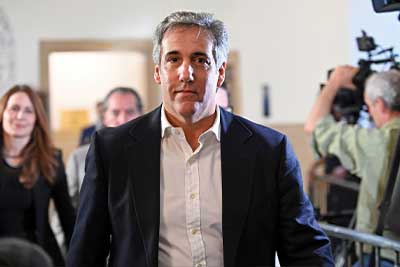
Witness for the prosecution: Former Trump lawyer Michael Cohen was the prosecution’s star witness, despite his multiple convictions on federal crimes and a three-year prison sentence. (AP Images)
Here is where the story verges into the Kafkaesque: In order for the alleged falsification of business records to be elevated from a misdemeanor to a felony, it is necessary under New York law for the action to include “an intent to commit another crime or to aid or conceal the commission thereof.” In this case, of course, the putative other crime was covering up the so-called hush money payments to Stormy Daniels, thereby influencing the outcome of an election. But such payments are not criminal, and proving criminal intent under such circumstances would be a well-nigh impossibly high bar for any prosecutor.
However, Trump was not charged with any such additional offenses, doubtless because Bragg, the grand jury, and a host of state and federal prosecutors and investigators had already gone over the evidence with a fine-toothed comb and found no basis for charging Trump with election fraud. Thus, the bizarre and novel legal theory that Trump could be saddled with 34 felony counts requiring evidence of motive to commit or cover up additional crimes — but for which additional crimes, owing to a lack of evidence, he would not be charged (and which crimes were not even specified in the indictments). Nevertheless, each of the charges carried a maximum sentence of four years in prison, raising for the first time the realistic prospect that Trump would end up in prison rather than on the hustings during the upcoming campaign season.
On April 4, to the usual celebratory media coverage, Trump was arraigned. He was booked and fingerprinted, but spared the additional indignities of handcuffs and mug shots, to the palpable disappointment of jeering media imps. Adding to the stagecraft, Merchan sternly warned Trump not to use social media to incite violence.
In the months leading up to the trial, the Trump team sought in vain to get the charges dismissed. The only thing that the court eventually conceded was that the “other crimes” Trump was alleged to be complicit in in order to justify the felony charges was a bit too vague. Instead, the court ruled that, for practical purposes and in the supposed interest of fairness to the defendant, the “other crimes” should be limited to only three categories that Trump had been alleged to have committed, which had been identified pre-trial, but none of which Trump had ever been charged with (federal election-law violations, falsification of business records, and tax violations).
Trump also tried to get a change of venue for the trial, pointing out that, in Manhattan, his electoral support was in the single digits. Under such conditions, it was inconceivable that Trump could receive a fair trial and be judged by any semblance of a jury of his peers. His request was flatly denied, further evidence that the aim of the entire proceeding was not to serve justice but to secure a conviction at any cost.
The trial was conducted as show trials usually are, with an indignant Trump, furious at the deliberate legal persecution masquerading as Lady Justice, frequently lashing out at the judge and prosecutors — for which Merchan eventually imposed a gag order, in flagrant violation of Trump’s right to free speech. Among the many outrages that incensed Trump and his legal team was the fact that Merchan was a prominent Democratic donor, and his daughter was actually a party operative.
The prosecution was allowed to produce a veritable parade of questionable witnesses, including, as their star, Michael Cohen himself, as well as Stormy Daniels, who delighted the news media with prurient and utterly irrelevant details of her alleged assignation with Trump. The Trump defense team, on the other hand, was denied the right to a key witness, Bradley Smith, former chair of the Federal Election Commission and an expert on election fraud (one of the secondary crimes that Trump had supposedly committed, in order to justify the felony charges). In the end, the defense rested after calling only two witnesses, paralegal Daniel Sitko and prominent lawyer Robert Costello. The latter, whose strong credentials might possibly sway the jury away from the intended guilty verdict, was subjected to a fiery and humiliating reprimand in court by Merchan, who excoriated him for supposedly rolling his eyes and otherwise conveying by body language that he did not revere the judge as an infallible and august arbiter.
On the day of closing arguments, attention was drawn to the fact that the prosecution, not the defense, had the final say, prompting Trump to complain of unfair privileging of the prosecution. On Truth Social, he wrote, “WHY IS THE CORRUPT GOVERNMENT ALLOWED TO MAKE THE FINAL ARGUMENT IN THE CASE AGAINST ME? WHY CAN’T THE DEFENSE GO LAST? BIG ADVANTAGE, VERY UNFAIR. WITCH HUNT.” Naturally, a host of smirking liberals were happy to dogpile Trump online, proclaiming confidently that this is how it’s always done, because the burden of proof rests on the prosecution. A criminal defense attorney named Tom Briody sneered on X that “Prosecutors always have the last word at final argument. Why? Because they have the burden of proof. Trump’s lawyers surely told him that. But he wants the world to know how ignorant he is.” A former federal prosecutor named Randall Eliason made the same point alongside a nasty dig at Trump and his white-collar ilk: “It’s funny how many white collar defendants develop a sudden interest in criminal justice reform. And btw — the answer is that because the state has the burden of proof, it gets the last word.” Another former federal prosecutor, Kristy Parker, sniffed, “I wonder if there’s ever been a person who occupied the presidency who was this ignorant about basic principles of our criminal justice system. Actually, I don’t wonder.”
The message is clear, if completely illogical: Because the state, not the defendant, has the burden of proof, it should have the last word. This illogic is typical of the lexicological legerdemain that lawyers are accustomed to indulge, assuming that those outside the legal profession are bereft of reason. But in truth, if the burden of proof truly rests on the state, it should be maximally handicapped — not advantaged — in its presentation. This is, after all, what is implied by the phrase “burden of proof.”
Many states do, in fact, allow the government a final response after the defense rests — this, after the defense has in effect rebutted an initial closing statement by the state. Fewer states, however, require the defense to go first and allow no subsequent response to whatever claims the government may make. New York adopts this latter format, with the judge supposedly responsible for reining in any prosecutorial misstatements or other outrages. And not all states handle closing arguments in either of these prejudicial manners. In North Carolina — to cite one counterexample — both the defense and prosecution ordinarily are allowed to give up to two statements during closing arguments, with the defense always having the last word, unless novel evidence is introduced, in which case the prosecution is allowed a rebuttal. Thus, if the defendant does not introduce any new evidence during closing arguments (the most likely scenario), then the defendant gives the opening address, followed by two presentations allowed for the prosecution, and concluding with the defendant’s closing address.
As for the evidence presented during closing arguments, Merchan allowed to stand numerous patently false and prejudicial statements by the prosecution. For example, prosecutor Joshua Steinglass was allowed to repeatedly tell the jury falsely that it was an established fact that Michael Cohen committed election fraud on direct orders from Donald Trump, despite the fact that this was never established in any prior judicial proceeding (or, for that matter, was even an offense with which Trump was charged). Merchan himself had said earlier that Cohen’s conviction could not be used to infer the guilt of Trump. Yet he overruled an objection by the defense to Steinglass’ prevarication, leaving the jury with the impression that, indeed, Trump had already been proven guilty of something by association.
Rigging the system: Judge Juan Merchan, another partisan Democrat, took few pains to conceal his bias against Trump and to tip the scales of justice in favor of the prosecution. (AP Images)
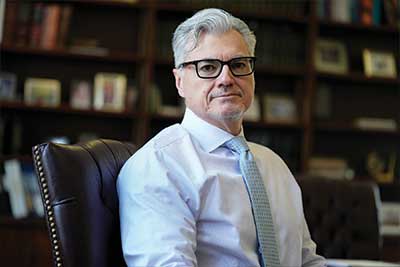
Merchan also allowed the prosecution to make other false assertions, such as that Hope Hicks had cried on the stand because she knew she had ruined Trump’s defense, and that media and political campaigns do not try to kill and plant stories as the Trump campaign had allegedly done. This last was particularly mendacious, since that is precisely what the Clinton campaign, with the help of a complicit media, did in the immensely damaging Trump-Russia Collusion hoax.
In the end, Merchan made sure that the jurors were left with the false impression that Trump was unquestionably guilty of federal campaign-law violations — and that the defense’s election-law expert, Bradley Smith, was barred from testifying to contest that narrative.
Perhaps the greatest affront to jurisprudential decency, common sense, and precedent came in Merchan’s long-winded instructions to the jury prior to deliberation. Far from being an impartial arbiter, Merchan made crystal-clear his commitment to a guilty verdict by effectively issuing instructions that all but guaranteed a conviction if followed to the letter. For one thing, the judge informed the jurors that they did not have to agree on what Trump did unlawfully to influence the 2016 election. He instead gave them three broad categories of misconduct — federal election violation, falsification of business records, and tax violations — any or all of which Trump might be guilty of — and assured them that, as long as they all agreed that Trump had done something under one of these three headings, that was sufficient for a unanimous guilty verdict.
Moreover, the judge in his instructions introduced an absurdly vague standard of general intent. As legal expert Jonathan Turley observed:
Allowing conviction based on a “general intent” to defraud “any person or entity” [is] a dangerously vague concept in this novel criminal case. Merchan has largely stuck to the standard jury instructions but this case is anything but standard. With an ambiguous claim of “influencing” an election, a general intent instruction without better definition to this case can be an invitation for bias.
As the guilty verdict on all 34 charges bears out, this invitation did not pass unheeded. What Turley characterized as a judicial “canned hunt” delivered the hoped-for result.
Whether this colossal miscarriage of justice will be righted anytime soon remains to be seen. It seems unlikely that judicial relief will be forthcoming on immediate appeal, given the thoroughgoing corruption of the New York justice system, from Trump-hating Attorney General Letitia James on down. The Supreme Court would seem to be the most likely source of relief, and that could come sooner than later, should the Trump defense team appeal for any of several writs to be applied to Merchan’s court to cease and desist its unlawful persecution of Donald Trump. Given the Supreme Court’s willingness to step in and overrule the obviously corrupt Florida judiciary in 2000 seeking ways to hand the election to Al Gore, it is not outside the realm of possibility that the Court might weigh in to put a stop to a corrupt judiciary engaging in lawfare and election interference.
With Trump’s sentencing to occur on July 11, no doubt plans are already being laid to ensure that it, as with the trial, has maximal political impact. Legal prognosticators who have consistently missed the mark on this trial (for example, predicting that the case would be dropped, or that the jury would fail to convict) have failed to appreciate that, as a show trial, the Bragg-Merchan kangaroo court is a political event, not a legal proceeding. Everything has been orchestrated to maximally handicap Trump politically — to strip him of his assets, to drag his name through the mud, and to physically prevent him from campaigning, among other things. Now that the long-sought felony conviction has been achieved, what happens next will probably have little to do with legal precedent or any pretense of equity. It will instead be whatever Trump’s enemies deem will be most likely to deliver the coup de grâce to his presidential campaign — and that means, of course, some type of confinement, whether house arrest or incarceration, possibly in addition to fines of unprecedented severity and persecution of other key Trump supporters. After all, New York law does allow a maximum of four years for each felony charge, to a maximum of 20 years (which for Trump would amount to a life sentence).
Is such an extreme sentence likely? In the opinion of this observer, some form of incarceration — probably prison — is the most likely outcome. Yes, it would further burnish Trump’s martyr credentials and boost his poll numbers, but the Deep State has already demonstrated a disdain for all such issues. Any number of nightmare scenarios could result from such an outcome, with one being Trump being elected as president, only for the state of New York to refuse to release him from custody, and in the ensuing chaos in the capital, key Biden officials at the DOJ and elsewhere refusing to step down, thereby preventing a transfer of power, while Democrats in Congress stage an open revolt and try to overturn the election results based on the 25th Amendment.
Such a dire scenario, or any number of others, looms large as this case moves toward some type of denouement. Under such circumstances, Supreme Court intervention might prove the only remaining legal remedy.


